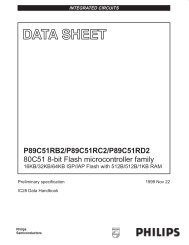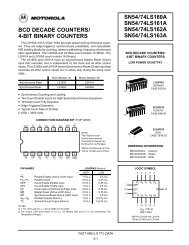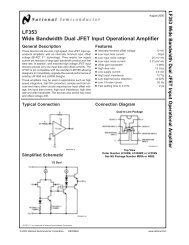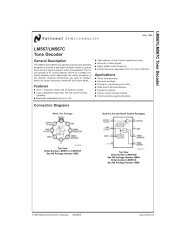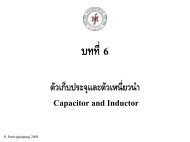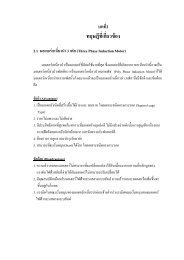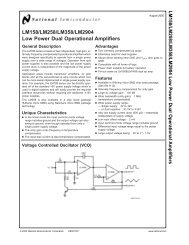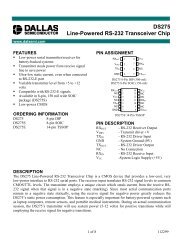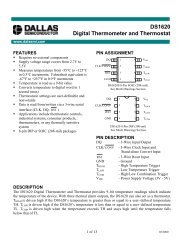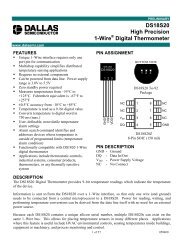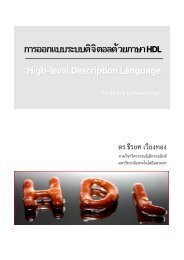tracking notch filter for electrocardiograph measurement
tracking notch filter for electrocardiograph measurement
tracking notch filter for electrocardiograph measurement
You also want an ePaper? Increase the reach of your titles
YUMPU automatically turns print PDFs into web optimized ePapers that Google loves.
1 >TFig. 14. Comparison between standard and <strong>filter</strong>ed ECG.Results of <strong>filter</strong>ing noise frequency of 60Hz show in Fig.15 to 17. Fig. 16(b) shows that spectral of the <strong>filter</strong>ed ECGsignal at frequency of 60Hz is eliminated when comparingwith Fig. 16(a). The MSE is of 1.44%.1) Ch 1: 500 mV 250 ms(a)(b)Fig. 18. (a) Un<strong>filter</strong>ed ECG (b) its Spectral.1 >T1 >T1) Ch 1: 500 mV 250 ms(a)(b)Fig. 19. (a) Filtered ECG (b) its Spectral.2 >T1) Ch 1: 500 mV 250 ms2) Ch 2: 500 mV 250 msFig. 15. Upper: ECG combined with noise frequency of 60Hz.Lower: Filtered ECG.(a)(b)Fig. 16. Spectral from analyzing by MATLAB.Fig. 17. Comparison between Standard and Filtered ECG.3.4. Filtering with Real ECG SignalUsing electrode as standard position to measure ECG signal inlead I, such ECG signal is connected to the isolated instrumentamplifier and output signal from one is fed to the designed<strong>tracking</strong> <strong>notch</strong> <strong>filter</strong>. The un<strong>filter</strong>ed and <strong>filter</strong>ed ECGwave<strong>for</strong>m is measured and recorded by WAVESTAR program.Fig. 18(a) and (b) show the un<strong>filter</strong>ed ECG wave<strong>for</strong>m and itsspectral, respectively. Also, Fig. 19(a) and (b) show the <strong>filter</strong>edECG wave<strong>for</strong>m and its spectral, respectively. Comparing Fig.18 and 19 shows that the designed <strong>tracking</strong> <strong>notch</strong> <strong>filter</strong> can<strong>filter</strong> out the noise frequency seeing in both time and frequencydomain.4. ConclusionsFrom frequency response of the designed <strong>tracking</strong> <strong>notch</strong><strong>filter</strong>, attenuation at each center frequency is approximately of-35dB to -38dB which is good enough. The difference of thecalculated and measured frequency from frequency synthesizer<strong>for</strong> which the multiplication is of 150 times is very close. Theper<strong>for</strong>mance by experiment with the noise frequency addedstandard ECG wave<strong>for</strong>m have shown the <strong>filter</strong>ed ECGwave<strong>for</strong>m in time domain without noise, frequency domainwithout spectral of noise frequency, and in term of MSE seeingthat it is low enough. Also, the per<strong>for</strong>mance of the real ECGsignal has shown the <strong>filter</strong>ed ECG wave<strong>for</strong>m in time domainwithout noise and in frequency domain without spectral ofnoise frequency, only.One of advantage of the designed <strong>tracking</strong> <strong>notch</strong> <strong>filter</strong> is thesmall circuit size when comparing with the closed loop bandstop <strong>filter</strong> and can use discrete component and passive device.In future, this <strong>filter</strong> will develop as a single chip.References[1] L. Bustamante and M. A. Soderstrand, “High-RangSwitched Capacitor Tracking,” IEEE InternationalSymposium on Circuits and Systems , vol. 1, pp. 688-691,May, 1999.[2] L. Bustamante, R. H. Strandberg, and M. A. Soderstrand,“Switched-Capacitor Adaptive Sampling Rate Notch Filter<strong>for</strong> Enhancement and Elimination of Bandpass Signal,”Proceeding Of the 40 th Midwest Symposium on Circuitsand System, vol. 2, pp. 1354-1357, August, 1997.[3] P. E. McSharry, G. D. Clif<strong>for</strong>d, L. Tarassenko, and L. A.Smith, “A Dynamical Model <strong>for</strong> Generating SynthesisElectrocardiogram Signals,” IEEE Trans. On BiomedicalEngineering, vol. 50, no. 3, pp. 289-294, March, 2003.190


